
Waste Management System, the
Alexandra way
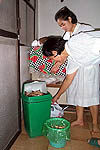
Segregation of wastes – the wet from the dry - starts from the unit/household. The
kitchen wastes are stored separately. The wet ones, which are usually non-recyclable are
put in the green plastic bag, and the dry ones, which are mostly recyclable are kept in
the black plastic bag. Once either of the bags is filled up, it is placed at the doorstep
ready for the janitor’s collection. The kitchen wastes are brought to the top floor
for processing by individual unit/household.
Composting of Kitchen Wastes
materials needed:
- not less than 4 pieces of #10 (10-inch
diameter) clay pots
- available in all public markets
- Happy Soil, a lactobacilli-laden soil –
supplied by the Lacto Asia Enterprise,
packaged at 2 kilograms per bag
- ordinary soil
- coconut dust
|
Each unit/household takes
care of its own kitchen wastes. It has its own pots, four to seven pots per
unit/household. Using clay pots, which are kept in their respective terraces or at the
rooftop of the building, kitchen wastes are processed by individual household.
Kitchen wastes include food trimmings, fish
gills, vegetables and fruit skins, seeds, pulp, tea bags, coffee grinds, coffee filters,
and leftover food. Vegetables, and leftover food are chopped into small pieces for faster
decomposition.
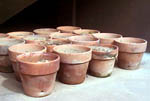 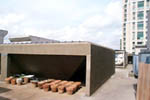
The process, which they call
"lasagna method", starts with a layer of soil (as the base) on which a layer
– preferably not more than 3 inches thick - of wastes is added. This is then covered
with a very thin layer of Happy Soil (which hastens the process of decomposition), and
another layer of ordinary soil. When the pot is filled up, a thin layer of coconut dust is
put on top to absorb the moisture and at the same time absorb the odor generated by the
process. The same process is followed in other pots.
The pots are put in the shaded area of the
rooftop and/or terraces. When they run out of shaded areas, plastic sheets are used to
keep the pots from getting wet or exposed directly to the heat of the sun.
Twenty days later, the decomposed wastes
can already be used as soil for the next round of compost.
Dry Wastes
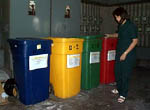 The black bag is left at the
respective doorstep of each unit and are regularly collected by the janitor assigned in
every building. At the utility area of the building, the contents are further segregated
by the building janitor according to the preferred choice of the buyer –
bottles/glasses, paper, cans, plastic. The black bag is left at the
respective doorstep of each unit and are regularly collected by the janitor assigned in
every building. At the utility area of the building, the contents are further segregated
by the building janitor according to the preferred choice of the buyer –
bottles/glasses, paper, cans, plastic.
A buyer of recyclable wastes visits
Alexandra every week to buy large volumes of dry wastes. The remaining wastes that are not
bought by the buyer are put back in the black plastic bags ready for pick up by the
government garbage collector.
Wet Wastes
The wet wastes which are placed inside the
green plastic bags are collected by the building janitor at the homeowner’s doorstep.
These go directly to a large garbage bin, ready for the garbage collection trucks.
Garden Wastes
A small area, approximately 5 by 3 meters,
is allotted at the back for the garden wastes, most of it are dry leaves. These are left
for a period of time to decompose.
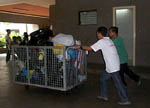
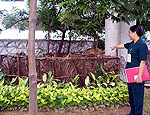
Building Management
Each building has one Administrative
Assistant. One of his/her functions is to monitor the garbage management of each household
– checking the composting process up on the roof, determining the regular users of
building’s garbage drop, monitoring which unit/s does/do not practice the proper
segregation of wastes, and identifying building champions.
Part of his/her regular task is to conduct
a regular seminar on garbage management (waste segregation, recycling, and composting) for
the homeowners and/or its representatives. The seminar is conducted monthly. This is to
take care of the constant change of household helps and the tendency of some residents to
relax a bit in their household waste management. He/she also conducts regular surveys
pertaining to this new solid waste management scheme so as to have feedback from the
residents. Suggestions from residents are regularly collected for evaluation.
At least one janitor is assigned in each
building. His tasks include, among others, the collection of the green and black bags left
at the doorstep of each unit, and the segregation of the contents of the black bags.
basic info |
initiative | strategy |
critical factors |
other links
| home
|

